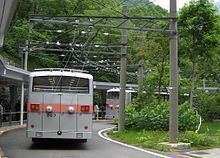 | ||
Kanden tunnel trolleybus kurobe dam tateyama japan
The Kanden Tunnel Trolleybus (関電トンネルトロリーバス, Kanden Tonneru Tororiibasu) is a Japanese trolleybus line between Ōgizawa Station, Ōmachi and Kurobe Dam Station, Tateyama. The line does not have any official name. The 6.1-km line runs almost entirely in a tunnel, except for about 300 metres at Ogizawa station and the approach to it. Opened in 1964, it is one of only two trolleybus lines currently existing in Japan. The line is a part of Tateyama Kurobe Alpine Route, together with another trolleybus line, Tateyama Tunnel Trolleybus.
Contents
26 09 29
History
The tunnel was originally built as access for the construction of the hydroelectric plant of Kurobe Dam, by the Kansai Electric Power Company (Kanden or KEPCO). It is only one lane wide, except for a short section near the middle, which is wider so as to allow vehicles going in opposite directions to pass. The trolleybus service began operation on 1 August 1964. After the dam and its power station were completed, KEPCO opened the tunnel for public use, as the power company had been ordered to do so by the Ministry of Health and Welfare. The single-lane tunnel was not suitable for cars, and there was no space for parking, so the company chose to build a trolleybus line in the tunnel.
Operation
The Kanden Tunnel trolleybus line has always been owned and operated by the Kansai Electric Power Company (KEPCO). Since trolleybus lines are legally considered as a sort of railway in Japan, KEPCO can be considered the railway operator with the largest capital stock in the country.
Basic data
During busy times, multiple trolleybuses operate through the tunnel in convoy. As many as 10 trolleybuses can be operated in a single convoy, if demand is great enough. In 1984, the line carried 1,066,000 passengers.
Fleet
The original fleet comprised six Mitsubishi Fuso trolleybuses with bodies by Osaka Sharyo Kogyo, built in 1964, numbered 101–106 (renumbered 111–116 in 1976). Additional vehicles built by the same manufacturers, to the same or very similar design, were acquired gradually—at a rate of about one new trolleybus per year—between 1966 and 1973, carrying fleet numbers 107–110 and 201–205 (renumbered 117–120 and 211–215 in 1976). The first six trolleybuses had only one door, at the front, but a second door was added in 1976, in the center. The next four (117–120) also had only a single door, and retained this configuration. The 200-series vehicles came with two doors. They had longitudinal seating, whereas the 100-series vehicles had forward-facing seats.
All of the 1964–1973 vehicles were withdrawn from service in the early to mid-1990s and replaced by a new fleet of nine trolleybuses built by the same two manufacturers, in 1993 and 1994, and numbered 301–309. Of the previous fleet, the first six were scrapped, but all nine of the others were donated to Mexico City's Servicio de Transportes Eléctricos (STE), for possible use there, arriving in Mexico City in 1994–1997, but they were never placed in service by STE.
